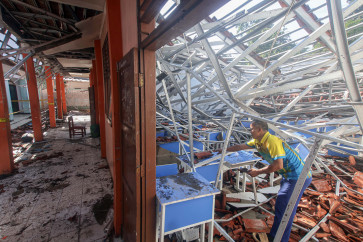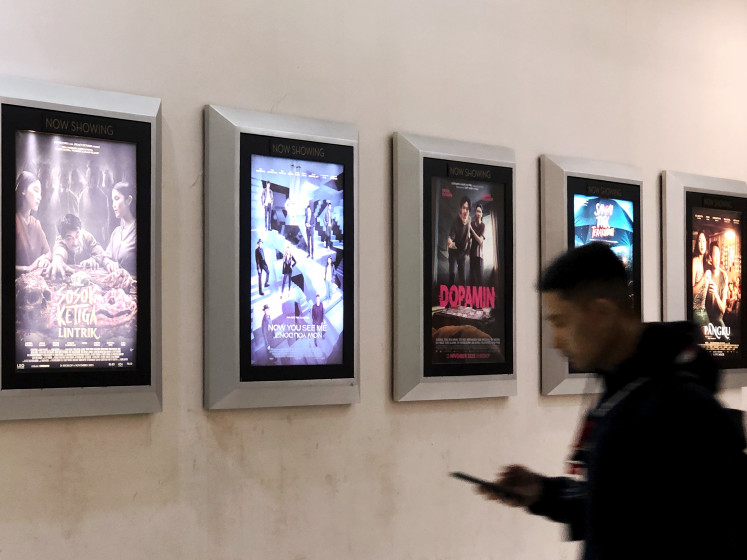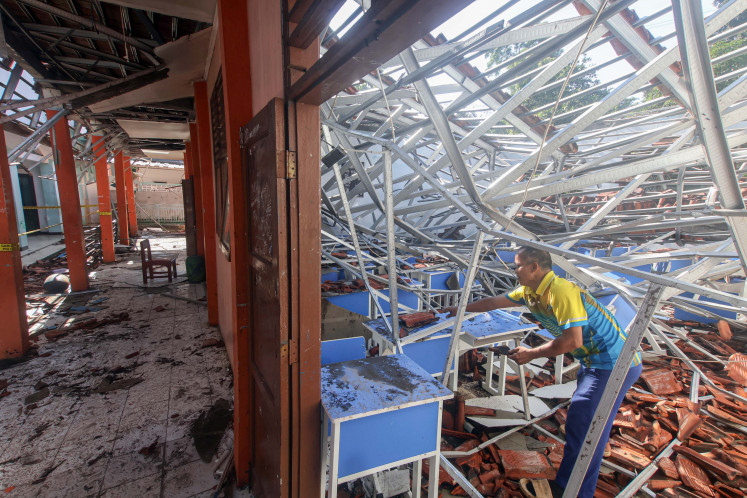Popular Reads
Top Results
Can't find what you're looking for?
View all search resultsPopular Reads
Top Results
Can't find what you're looking for?
View all search resultsPapuan self-determination movement: Where is it heading?
Energized: Papuans and human rights activists participate in a rally in front of the Merdeka Palace in Jakarta on Aug
Change text size
Gift Premium Articles
to Anyone
E
nergized: Papuans and human rights activists participate in a rally in front of the Merdeka Palace in Jakarta on Aug. 22. They were demanding the government punish perpetrators of racial abuse against Papuan students in Surabaya, East Java, or hold a referendum to free Papua and West Papua. The government has suspended military members allegedly involved in the Surabaya incident.(JP/Seto Wardhana)
The recent protests in Papua, West Papua and other regions have brought the issue of a Papuan referendum on self-determination to the forefront of the national debate.
The central government has said that a referendum is not an option, with President Joko “Jokowi” Widodo saying that the issue of Papuan sovereignty had already been “resolved”.
Coordinating Political, Legal and Security Affairs Minister Wiranto has also dismissed calls for a Papuan referendum, despite increasing calls from protesters for self-determination.
“I think that [demands for a referendum] are inappropriate,” he said recently. “The NKRI [Unitary State of the Republic of Indonesia] is final.”
Colonial times
Very little is recorded about the history of Western New Guinea before contact with colonial powers in the mid-16th century. In an article for the Journal of Southeast Asian History, Robert C. Bone described 16th century New Guinea as “probably the most masterless area in all the world”.
In 1660, the Dutch East India Company witnessed the signing of a treaty between the rival Moluccan sultanates of Tidore and Ternate, in which Tidore was given sovereignty over “the Papuans, or all of their islands.”
The Kingdom of the Netherlands laid claim to the western part of New Guinea in 1828 on the basis that it was part of the Sultanate of Tidore, which had become a Dutch vassal state in 1780.
By November 1884, however, the British and German empires had recognized Dutch sovereignty over the western part of the island, with the 141st parallel demarcating the boundaries of “Netherlands New Guinea.”
The region remained on the periphery of the Dutch East Indies for most of the remaining period of Dutch colonial rule.
West Irian issue
As nationalists prepared to declare Indonesia’s independence in 1945, the issue of whether Papua, then also known as West Irian, should be part of the soon-to-be independent nation became a matter of debate for the country’s founding fathers.
When the Agency for the Preparatory Work for Indonesian Independence (BPUPKI) held meetings between May and July in 1945, Mohammad Yamin argued that West Irian should be part of Indonesia based on the same claims of Tidorese sovereignty that were previously used by the Dutch.
“According to Indonesian understanding, a large part of the island of Papua is part of the land of the Kingdom of Tidore, so the region is automatically part of the territory of Indonesia,” Yamin said, as recorded in the minutes of a BPUPKI meeting on July 10, 1945.
Not long after Indonesia declared independence on Aug. 17, 1945, the newlyformed country became involved in an armed conflict with the Dutch, who wanted to reclaim the former colony. The conflict lasted until 1949, when the two sides met in The Hague to discuss the transfer of sovereignty. The status of West Irian remained a sticking point, however, and as a compromise, the conference concluded that the region’s status would be determined through negotiations between Indonesia and the Netherlands within a year of the transfer of sovereignty.
After 1949, anti-Indonesian sentiment among the Dutch led it to institute a new indigenous education policy in Netherlands New Guinea to prepare indigenous inhabitants to govern an independent Papua, a decision that political researcher Bobby Anderson said was “born from vindictiveness”.
This process culminated in 1961, when the Dutch administration held elections for a Papuan representative body called the New Guinea Council. The Council appointed a national committee that then drafted a manifesto declaring the Papuan desire for independence and designating the Bintang Kejora (Morning Star) flag as the national flag and “Hai Tanahku Papua” as the national anthem.
The Morning Star flag was first raised in a ceremony in front of the New Guinea Council building in Hollandia, now Jayapura on Dec. 1, 1961, a date that many Papuans consider to mark Papua’s independence day.
Operation Trikora, New York Agreement and Act of Free Choice
The raising of the Morning Star flag triggered then-president Sukarno to establish the People’s Triple Command (Trikora) on Dec. 19, 1961, with the aim of taking over West Irian by March 1963. Indonesia’s attacks were largely repelled by Dutch forces.
By 1962, however, the Netherlands recognized Indonesia’s determination to take the territory and came to the negotiating table, in order to put an end to what Sukarno biographer J.D. Legge described an “increasingly unprofitable and distasteful commitment to the last remnant of her former Indian empire”.
Thus on Aug. 15, 1962, the Republic of Indonesia and the Kingdom of the Netherlands signed the New York Agreement on the administration of West New Guinea under the auspices of the United States and the United Nations.
In the agreement, the Netherlands agreed to transfer West New Guinea to a United Nations Temporary Executive Authority (UNTEA), which would in turn transfer the administration of the region to the Indonesian government, pending a referendum on self-determination.
The UNTEA turned over West Irian to Indonesia on May 1, 1963, after which the New Guinea Council was disbanded and Papuan political expression was severely curtailed.
Between July 14 and Aug. 2, 1969, the Indonesian government held a referendum on the fate of West Irian in accordance with the New York Agreement, called the Act of Free Choice (Pepera).
Unlike common international practice on plebiscites, however, the referendum did not use the principle of “one man, one vote”, as the government argued that such an arrangement was not required by the New York Agreement.
Instead the government insisted that “consultative assemblies” be elected to represent the Papuan people in the vote. The assembly elections, held in May, have been criticized by observers and activists as fraudulent.
In the end, the 1,025 chosen assembly members publicly and unanimously voted in favor of Indonesian rule.
OPM and armed rebellion
Disappointment over the lack of Papuan involvement in the New York Agreement and discontent toward Indonesian rule triggered an armed rebellion not long after Indonesia took over the administration of West Irian from the UNTEA.
On July 26, 1965, former soldiers of the Dutch-formed Papuan Volunteer Corps (PVP) attacked Indonesian military and police posts in Kebar district.
Two days later, armed men led by former PVP sergeant Ferry Awom attacked Indonesian Armed Forces (ABRI) personnel in Arfak, Manokwari. These events are considered to be the first significant activities of the Free Papua Movement (OPM).
‘Papuan Spring’ and formation of nonviolent separatist groups
Following the fall of the New Order, the region went through a period where there was increased room for political expression that some researchers call the “Papuan Spring.”
The period saw the formation of several Papuan nationalist organizations by educated Papuans including the Forum for Reconciliation in Irian Jaya (FORERI), the Papuan Students’ Alliance (AMP) and the Papuan Presidium Council.
The era also saw the rise to prominence of several highly educated, nonviolent Papuan independence activists, such as Filep Karma and Papua Presidium Council leader Theys Hiyo Eluay.
Then-president Abdurrahman “Gus Dur” Wahid lifted the ban on the Morning Star flag and the “Hai Tanahku Papua” anthem, while also granting special autonomy status to Papua.
The “Spring” ended with the deposition of Gus Dur in 2001. His successor, Megawati Soekarnoputri, took a more hardline approach toward any expression of separatism, while her successor, Susilo Bambang Yudhoyono, brought back restrictions on the Morning Star flag through a 2007 presidential regulation.
Papuan activists were also suppressed: Theys Eluay was kidnapped and killed by members of the Indonesian Army’s Special Forces (Kopassus) in 2001 and Filep Karma received a 15-year prison sentence for treason in 2004.
In 2004, Papuan separatist figure Benny formed the Free West Papua Campaign together with other pro-Papuan independence activists in Oxford. The campaign aims to lobby foreign governments to raise awareness and gain support for Papuan self-determination.
In 2014, four Papuan separatist organizations formed an umbrella group called the United Liberation Movement for West Papua (ULMWP). Its leadership, which includes Benny, mostly resides overseas. In 2016, the group requested to become a full member of the Melanesian Spearhead Group (MSG), a subregional group of Pacific island countries, but was rebuffed after intensive lobbying from the Indonesian government.
Renewed calls for referendum
Triggered by an incident of racial abuse of Papuan university students in Surabaya, thousands of Papuans took to the streets to protest in various cities and regencies across Papua and West Papua starting on Aug. 19.
Hundreds of Papuan students were emboldened enough to call for a referendum in front of the State Palace in Central Jakarta while carrying the banned Morning Star flag on Aug. 29.
The government has reacted to the demands with a swift crackdown: eight people who participated in the Jakarta protests were arrested last week, while dozens of other protesters were arrested
Last Wednesday, police named human rights lawyer Veronica Koman, who is also a member of the National Committee for West Papua’s (KNPB) legal team, a suspect for allegedly “provoking” the protests. Her passport has since been revoked.










